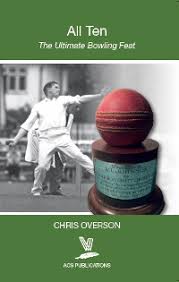All Ten
Martin Chandler |Published: 2017
Pages: 297
Author: Overson, Chris
Publisher: ACS
Rating: 4 stars

There have been 81 occasions in First Class cricket when a bowler has taken all ten wickets in a First Class innings, an achievement Chris Overson describes in his sub title as The Ultimate Bowling Feat. There was a time when, in relative terms, it was not a rare occurrence. In the 21 summers between the wars it was done 24 times, which is in stark contrast to the four occasions this century. The last man to achieve the mark was Zulfiqar Babar, back in 2009.
In his book Overson devotes around 1,500 words to each of the 76 men who have taken all ten (‘Tich’ Freeman, uniquely, did so on three occasions and Hedley Verity, Jim Laker and Edward Walker twice). He concentrates on the matches concerned although all the essays give an outline of the lives and careers of the men concerned. Some, like Laker and Verity, are amongst the most lauded bowlers to have played cricket. Others, such as Tom Graveney’s brother Ken and student Tony Pearson, left much less of an impression on the game.
The essays are a diverse lot, and the research must have been interesting. The famous names would have been relatively straightforward, and by far the majority of instances have occurred in England or Wales, although on a purely statistical basis there has been a sea change there. Of the first 62 full sets, taking the story to 1957, only seven took place overseas. Since then only five of the 19 have not done so. Of those that occurred on the sub-continent only Anil Kumble’s performance in the Delhi Test against Pakistan in 1999 attracted very much attention in the northern hemisphere, so finding the details of the great days of Shahid Mahmood, Premangsu Chatterjee, Pradeep Sundaram, Imran Adil and Naeem Akhtar must have been a challenge.
One useful measure of the quality of a book such as this, essentially a collection of pen portraits that share a common theme, is the extent to which it inspires its reader to further research and that certainly applies here and particularly, for this reviewer, men like Gubby Allen, Alonzo Drake and the New Zealander Albert Moss.
As is to be expected from a book published by the ACS All Ten has an introduction that poses a few questions, in this case looking at the trends the later narrative highlights. Wisely Overson does not attempt to provide answers, preferring just to raise the issues and throw out a few ideas. It is an introduction that it is well worth returning to after finishing the book, and after dwelling for a few minutes on the collection of ‘statistics’ that close matters. In that respect I will throw out one ‘spoiler’. If you start reading All Ten from the beginning a number of questions are prompted, all of which are answered at the end. So there is no need to break off whilst reading in order to visit CricketArchive to establish the highest innings total when all ten have been taken, the most deliveries required to take all ten, who had the fewest career wickets before achieving his all ten, and so on and so forth.
If there is any justice in this world All Ten is a book that will find a market well beyond the confines of its publisher’s membership. That it is well researched is all but a given, but it is entertainingly written as well, and contains one of the best forewords I have read in a cricket book. It is not a long piece, but the thoughts of Richard Johnson on a subject close to his heart are fascinating. In a career that injury never allowed to fully blossom Johnson’s 10-45 for Middlesex against Derbyshire way back in 1994 remains the last time an Englishman achieved The Ultimate Bowling Feat.






Leave a comment